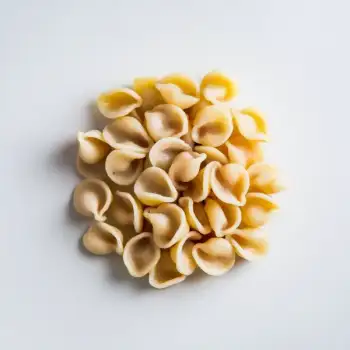Orecchiette and Farfalle are two types of Italian pasta known for their unique shapes and ability to pair with different sauces and ingredients, ideal for various dishes from hearty to light and creamy.

Orecchiette, meaning 'little ears' in Italian, are small pasta shapes reminiscent of a small ear, with a round, concave structure. Originating from the Puglia region, they are traditionally made from durum wheat semolina and are known for their ability to hold sauces and small ingredients, making them ideal for rich and hearty pasta dishes.

Farfalle, often referred to as 'bow-tie' pasta, is a type of pasta that is pinched in the middle to resemble a butterfly or bow-tie shape. It's made from sheets of pasta that are cut into rectangles and then pinched to create the distinctive shape. Farfalle pasta is versatile and holds onto light and creamy sauces well, making it a favorite for cold pasta salads and delicate sauces.
Orecchiette and Farfalle differ in shape, texture, and the types of sauces they best accompany. Orecchiette's cup-like structure allows it to trap hearty, chunky sauces and small ingredients, while Farfalle's smooth, flat surfaces are ideal for lighter, creamier sauces. Additionally, Orecchiette is more commonly associated with rustic, Southern Italian cuisine, whereas Farfalle is used across various Italian regions and is popular in a wider variety of dishes.

Your ultimate Recipe Box, Meal Planner, and Cooking Class all in one
In pasta salads, Orecchiette pairs well with robust ingredients like roasted vegetables, beans, and chunks of cheese. Their shape allows them to scoop up and hold onto the dressing and mix-ins, offering a satisfying bite. Use Orecchiette when you want a pasta salad that's hearty enough to be a meal on its own. Farfalle is excellent for light and refreshing pasta salads, especially those with a vinaigrette base. Its wide, flat surfaces are adept at holding onto thinner dressings and its shape adds an aesthetic appeal to the dish. Choose Farfalle for pasta salads served as a side dish or at picnics and potlucks.
Orecchiette is best served with thick, hearty sauces like ragù or broccoli and sausage, where its concave shape ensures a perfect sauce-to-pasta ratio in every bite. This pasta is ideal for dishes where you want the pasta to be as flavorful as the sauce components. While Farfalle can also handle hearty sauces, its best use in such cases is with chunkier vegetable-based sauces or Bolognese where the pieces can nestle into the pasta's center. It offers a different texture and experience, with a more even distribution of sauce over the surface.
Orecchiette can be used with creamy sauces, though it's not as traditional. It works well when the sauce has added texture from ingredients like peas or pancetta, providing a contrast to the creamy consistency. Farfalle shines with light and creamy sauces such as Alfredo or a simple lemon butter sauce. Its edges offer a pleasant bite, while the pinched center captures just enough sauce for a balanced flavor. It's a great choice for elegant yet simple dishes.
Both Orecchiette and Farfalle are similar in nutritional content, being primarily composed of durum wheat semolina. The main differences will come from the specific brand and whether whole wheat options are chosen.
Yes, you can substitute Orecchiette for Farfalle in pasta salads, but the texture and interaction with the dressing will be different due to Orecchiette's shape.
Orecchiette is best with thick, hearty sauces that can get trapped in its concave shape, such as ragù or vegetables with a chunky texture.
They can be used interchangeably to some extent, but due to their differing shapes, the final dish will have a different texture and sauce distribution.
Farfalle is commonly used in pasta salads, light and creamy sauce dishes, and can also be used in soups or baked pasta dishes.
Orecchiette is a staple in the Puglia region of Italy and is traditionally used in dishes such as 'Orecchiette with Broccoli Rabe' and 'Orecchiette with Ragù'.